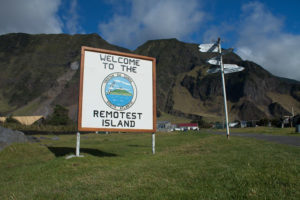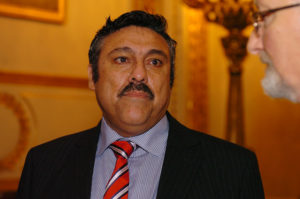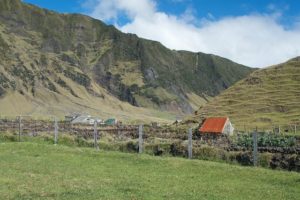A “collective spirit” still sustains Tristan da Cunha, the New York Times argues in a wonderfully illustrated story published on the Times website on May 20. The descriptive text and the photos of the island and its inhabitants are by Andy Isaacson, who spent a month there in 2009. He supplemented his investigation with recent conversations with the islanders.

He sets the scene for readers quite effectively by describing the extreme isolation of the island. The settlement, home to roughly 250 citizens of the U.K., claims to be the world’s most isolated human community. Located on a volcanic island roughly 6 miles in diameter, Tristan is about halfway across the South Atlantic between South Africa and Brazil. It has no airport so the only way to get there is to book passage on one of the occasional merchant ships sailing out of Cape Town. The isolation is an important factor in sustaining the culture of the island.
Isaacson briefly reviews the history of the island, which was discovered by Tristão da Cunha, a Portuguese explorer, in 1506. Over 200 years later, in 1817, the British established a garrison there as a measure to prevent the French from using it as a possible base for freeing Napoleon, whom they had imprisoned on St. Helena, another island located 1,500 miles to the north.
When the British government withdrew the garrison, Corporal William Glass and two associates were granted their request to be allowed to stay and establish a colony. The author mentions that the first settlers drafted a constitution of sorts forming “a new community based on equality and cooperation.” He argues that the same spirit established by the founders has sustained the islanders due to the nearly complete isolation.

He spoke with the Chief Islander, Conrad Glass, about this issue during his visit. Glass said that it was important for them to do business with the outside world, especially since they want to import some manufactured goods. The official added, however, that “the world can keep its bombs and bird flu. Whatever we’ve got here is under our control. It’s the remoteness of the island that has jelled us and brought us all together.”
Mr. Isaacson contacted the current Chief Islander, James Glass, a second cousin of Conrad’s, to find out how they are handling the COVID-19 pandemic. There have been no cases so far, but future visits of cargo and cruise ships have been banned. Preventing visitors will certainly help keep the islanders safe and they are not worried about their food supplies since there are plenty of lobsters in the surrounding sea and potatoes in the ground. Besides, their health center has only two beds and no ventilators—clearly inadequate if the pandemic should arrive.

The charm of the article is in the author’s descriptions of his visit and the photos he took while he was there. He was in the island’s café one day when the television was broadcasting one of Barack Obama’s news conference. The President was saying something about missile defense and Russia. It seemed so distant and irrelevant compared with the conversations of the locals about their potato crop.
Another day he strolled out the road to the south of The Settlement leading to the Potato Patches, the relatively level area where the islanders do their gardening. The café, the gardens—those are the realities of life on Tristan da Cunha, in addition to keeping the broader world safely at bay, he seems to be saying.